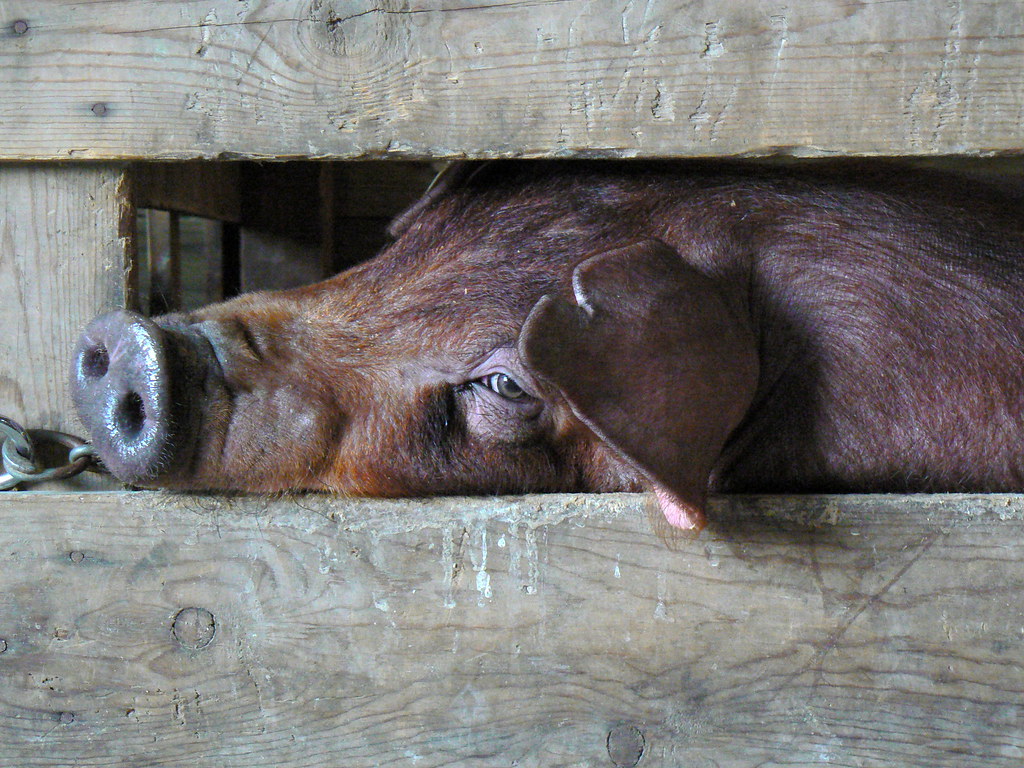When researching genealogy, a way to make our ancestors’ stories really interesting is to search out each and every nugget of information we can find. When searching for these bits of information, you’ll need to think about who your ancestor was, what your ancestor did, where your ancestor was and when your ancestor lived. Answering these questions can lead you to some unusual resources. Let’s look at some of these resources.

Photo by Benny Mazur. “Notch-ear.” License agreement.
One of the earliest forms of livestock Indiana pioneers kept were pigs. Pigs could be left to roam and forage in the woods and then captured when it was time for butchering. At butchering time, to know whose pig was whose the pioneers would make different notches in the pigs’ ears. The owner of the pigs could then register their stock mark at the county courthouse.
I was fortunate to find my ancestor Absalom Hoover’s stock mark in the pamphlet files in the Genealogy Division of the Indiana State Library. My ancestor’s stock mark looks like this: “Absalom Hoover Stock Mark, a crop off the right ear and a Slit in the left Recorded 11th March A.D. 1835 Saml Hannah Clk” Wayne County, Indiana, Stock Marks, Record A, Mar. 1815-Apr. 1822, call number: [Pam.] ISLG 977.201 W UNCAT. NO. 6.
As I found out, my ancestors were not just farmers, but also tavern owners. You may discover that your ancestor was also a tavern owner. To start your search for a tavern owner ancestor, search the Flagon and Trencher Society’s Ancestors lists. Once you have determined your ancestor was a tavern owner, you can search for tavern histories and petitions to open a tavern in court records. My ancestor Enos Veal was a tavern owner in New Jersey. Using the Family Search database – free with registration – I was able to find his tavern petition in the Early Courthouse Records of Gloucester County, New Jersey.
If you have relatives that lived in Delaware County in Indiana, a fun resource to use is the What Middletown Read database. In this database, you can search by name to see what your ancestors read. For example Maggie Gessell read 115 items, one of which was “When Charles the First was King: A Romance of Osgoldcross, 1632-1649.” There is supplemental information on the database about Maggie Gessell, so from this database alone – I know that Maggie’s mother was Narcissa Gessell, her son was Arthur C. Osborn and she was divorced. From the Transcribed Ledger data on the database, I also know that she lived at 418 E. Jackson St. and was once known as Mrs. Maggie Vance.

The Daily Banner, Greencastle, Putnam County, 9 April 1968 page 1. Contributed by DePauw University Libraries via the Hoosier State Chronicles database.
The places our ancestors lived are full of events that our ancestors experienced. When my father was a teenager in Richmond, Indiana in the 1960s he experienced a gas explosion that could be heard and felt all over town. To find out more about this event, I checked the GenDisasters database. I found the event and discovered that it happened in April of 1968. To learn more about the disaster, I searched the newspaper databases provided by the Indiana State Library. You can search the following databases at the library: Newspaper Archive and Newspapers.com; the Hoosier State Chronicles is available for use from your home. I also could have searched the city of Richmond newspapers on microfilm in the Indiana Division of the Indiana State Library for even more information.
I encourage you to try some of these unusual resources to complete the picture of who you ancestors were and what your ancestors did.
Additional online sources to explore:
Index to Livestock Marks Registered in Hendricks County, Indiana (1824-1848) – provided as a free resource from the Allen County Genealogy Center.
Stock Marks Recorded in South Carolina, 1695-1721
Stock Marks of Tyrrell County, North Carolina 1736-1819
Stock Marks Aren’t Just Brands – Use them to Identify People
Some Early Indiana Taverns – Indiana Magazine of History, Volume 1, Issue 2, June 1905
Tavern Keepers 1797-1862 – Delaware County, N.Y.
Little pilgrimages among Old New England inns; being an account of little journeys to various quaint inns and hostelries of colonial New England
Records relating to Taverns – State of New Jersey Department of State
Tavern Petitions, 1700-1923 – Chester County Pennsylvania Archives
Sources to explore at the Indiana State Library:
“Index to Livestock Marks Registered In Hendricks County, Indiana (1824-1848)” – provided as a free resource from the Allen County Genealogy Center
“Stockmarks, Kosciusko County, Indiana, 1836-1863. Townships: Franklin, Jackson, Plain, Turkey Creek, Wayne, VanBuren,” [Pam.] ISLG 977.201 K UNCAT. NO. 3
“Stock mark record book Warrick County, Indiana,” ISLG 977.201 W295ST
“Pike County, Indiana register of stock marks,” ISLG 977.201 P636HP
“Stock marks [Decatur County, Ind., recorded 1822-1871],” ISLI 977.201 D291S
“Wayne County, Indiana, stock marks, Record A, Mar. 1815-Apr. 1822,” [Pam.] ISLG 977.201 W UNCAT. NO. 6
“Warren County, Indiana : stock marks recorded Oct. 1827 to May 1931,” ISLG 977.201 W286DW
“Curtis Gilbert’s list for marks and brands on stock [taken from his account books at Fort Harrison, Sullivan County, Indiana],” [Pam.] ISLG 977.202 F UNCAT. NO. 1
“Old taverns: an interesting pamphlet descriptive of historic taverns, ordinaries, inns, hotels and houses of entertainment as well as customs and rates,” [Pam.] ISLG 976.901 H323 NO. 2
“The taverns & turnpikes of Blandford: 1733-1833,” ISLG 974.402 B642W
“A sketch of Fraunces’ tavern and those connected with its history,” [Pam.] ISLG 974.702 N567 NO. 1
“Washington Hotel and Tavern ledger, 1789-1793, Princess Anne, Somerset County, Maryland,” [Pam.] ISLG 975.201 S UNCAT. NO. 1
“Taverns and travelers inns of the early Midwest,” ISLI 647.94 Y54t
“What Middletown Read: print culture in an American small city,” ISLI 028 F324w
This blog post is by Angi Porter, Genealogy Division librarian.


